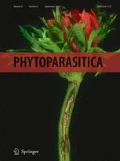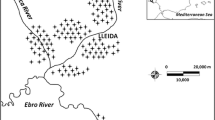Abstract
A total of 108 isolates of cucurbit powdery mildew (CPM) fungi, 78Golovinomyces cichoracearum (Gc) and 30Podosphaera xanthii (Px), originating from nine Czech regions and 22 districts of the Czech Republic were collected in the years 2001–2004. These isolates were screened for tolerance and/or resistance to the three frequently used fungicides (fenarimol, dinocap, benomyl). Fungicide sensitivity was determined by a modified leaf-disc bioassay with five concentrations. Fungicide efficacy differed significantly: fenarimol was the most effective and all isolates of both CPM were controlled by the recommended concentration (36µg a.i. ml−1). Some isolates expressed resistance (profuse sporulation) or tolerance (limited sporulation) to lower concentrations (9.6 and 18µg a.i. ml−1). Specific temporal variation in tolerance/resistance was observed, with some isolates ofGc from 2002 evincing tolerant or resistant reactions to these low fenarimol concentrations, but isolates with similar reactions were not detected during the years 2003–2004. Dinocap showed decreasing efficacy during all 3 years. A shift to more tolerant reactions in the CPM populations was detected forGc in 2001–2002, and forPx in 2001 and 2004. Benomyl was found to be ineffective, because the majority of screened isolates (88%Gc and 97%Px) belonged to the highly resistant strains, with resistant reaction on the recommended concentration (250µg a.i. ml−1) and tolerance or resistance on higher concentrations (500 and 1000µg a.i. ml−1). Sensitivity differed between the CPM species. Whereas practically allPx isolates (except one from 2003) were resistant, 12% ofGc isolates from the years 2001–2003 showed sensitive and/or tolerant reactions. In 2004, only benomyl-resistantGc strains were detected. Variation in tolerance/resistance was detected to all screened fungicides during the course of this study at some repeatedly sampled locations.
Similar content being viewed by others
References
Bardin, M., Carlier, J. and Nicot, C.P. (1999) Genetic differentiation in the French population ofErysiphe cichoracearum, a causal agent of powdery mildew of cucurbits.Plant Pathol. 48:531–540.
Bertrand, F., Pitrat, M., Glandard, A. and Lemaire, M.J. (1992) Diversité et variabilité des champignons responsables de l’oïdium des cucurbitacées.Phytoma 438:46–49.
Blatter, E.H.R., Brown, M.K.J. and Wolfe, S.M. (1998) Genetic control of the resistance ofErysiphe graminis sp.hordei to five triazole fungicides.Plant Pathol. 47:570–579.
Brown, M.K.J. (2002) Comparative genetics of avirulence and fungicide resistance in the powdery mildew fungi.in: Bélanger, R.R., Bushnell, R.W., Dik, J.A. and Carver, W.L.T. [Eds.] The Powdery Mildews. A Comprehensive Treatise. APS Press, St. Paul, MN, USA. pp. 56–65.
Buchenauer, H., Budde, K., Hellwald, H.K., Taube, E. and Kirchner, R. (1984) Decreased sensitivity of barley powdery mildew isolates to triazole and related fungicides.Proc. British Crop Protection Conference on Pests and Diseases (Brighton, UK), pp. 483–488.
Cohen, R., Burger, Y. and Katzir, N. (2004) Monitoring physiological races ofPodosphaera xanthii (syn.Sphaerotheca fuliginea), the causal agent of powdery mildew in cucurbits: factors affecting race identification and the importance for research and commerce.Phytoparasitica 32:174–183.
Delye, C., Bousset, L. and Corio-Costet, F.M. (1998) PCR cloning and detection of point mutations in the eburicol 14(alfa) demethylase (CYP51) gene fromErysiphe graminis f.sp.hordei recalcitrant fungus.Curr. Genet. 34:399–403.
Gisi, U. (2002) Chemical control of downy mildews.in: Spencer-Phillips, N.T.P., Gisi, U. and Lebeda, A. [Eds.] Advances in Downy Mildew Research. Kluwer Academic Publishers, Dordrecht, the Netherlands. pp. 119–159.
Hollomon, W.D. and Wheeler, E.I. (2002) Controlling powdery mildews with chemistry.in: Bélanger, R.R., Bushnell, R.W., Dik, J.A. and Carver, W.L.T. [Eds.] The Powdery Mildews. A Comprehensive Treatise. APS Press, St. Paul, MN, USA. pp. 249–255.
Jahn, M., Munger, M.H. and McCreight, D.J. (2002) Breeding cucurbit crops for powdery mildew resistance.in: Bélanger, R.R., Bushnell, R.W., Dik, J.A. and Carver, W.L.T. [Eds.] The Powdery Mildews. A Comprehensive Treatise. APS Press, St. Paul, MN, USA. pp. 239–248.
Kendall, J.S. (1986) Cross-resistance of triadimenol-resistant fungal isolates to other sterol C-14 demethylation inhibitor fungicides.Proc. 1986 British Crop Protection Conference — Pests and Diseases (Brighton, UK), pp. 539–546.
Křıstková, E., Lebeda, A., Sedláková, B. and Duchoslav, M. (2002) Distribution of cucurbit powdery mildew species in the Czech Republic.Plant Prot. Sci. 38 (Special Issue 2):415–416.
Křıstková, E., Lebeda, A., Sedláková, B., Duchoslav, M. and Dančák, M. (2003) Distribution of powdery mildew species on Cucurbitaceous vegetables in the Czech Republic. Scientific Works of the Lithuanian Institute of Horticulture and Lithuanian University of Agriculture.Hortic. Veget. Growing 22(3):31–41.
Kuck, K.-H. and Russell, E.P. (2006) FRAC: Combined resistance risk assessment.Asp. Appl. Biol. 78:3–10.
Kužma, Š. [Ed.] (2004) Seznam registrovaných přípravkøu na ochranu rostlin 2004 [List of the Registered Plant Protection Products 2004]. Státní rostlinolékařská správa [The State Phytosanitary Administration], Praha, Czech Republic (Czech, with English summary).
Lebeda, A. (1983) The genera and species spectrum of cucumber powdery mildew in Czechoslovakia.Phytopathol. Z. 108:71–79.
Lebeda, A. (1984) Screening of wildCucumis species for resistance to cucumber powdery mildew (Erysiphe cichoracearum andSphaerotheca fuliginea).Sci. Hortic. 24:241–249.
Lebeda, A. (1986) Padlí okurkové.Erysiphe cichoracearum, Sphaerotheca fuliginea [Cucumber powdery mildew.Erysiphe cichoracearum, Sphaerotheca fuliginea].in: Lebeda, A. [Ed.] Methods of Testing Vegetable Crops for Resistance to Plant Pathogens. VHJ Sempra, Research Institute of Vegetable Crops, Olomouc, Czechoslovakia. pp. 87–91 (Czech, with English summary).
Lebeda, A. and Křístková, E. (1994) Field resistance ofCucurbita species to powdery mildew (Erysiphe cichoracearum).J. Plant Dis. Prot. 101:598–603.
Lebeda, A. and Křístková, E. (1996) Genotypic variation in field resistance ofCucurbita pepo cultivars to powdery mildew (Erysiphe cichoracearum).Genet. Res. Crop Evol. 43:79–84.
Lebeda, A., Křístková, E. and Doležal, K. (1999) Peroxidase isozyme polymorphism inCucurbita pepo cultivars with various morphotypes and different level of field resistance to powdery mildew.Sci. Hortic. 81:103–112.
Lebeda, A. and Sedláková, B. (2004) Disease impact and pathogenicity variation in Czech populations of cucurbit powdery mildews.Proc. Cucurbitaceae 2004, 8 th EUCARPIA Meeting on Cucurbit Genetics and Breeding (Olomouc, Czech Republic), pp. 281–287.
Lebeda, A. and Sedláková, B. (2004) Species spectrum, pathogenic variability and fungicide resistance in cucurbit powdery mildew.Rostlinolékař 15(6):15–19 (Czech, with English summary).
Lebeda, A. and Sedláková, B. (2006) Identification and survey of cucurbit powdery mildew races in Czech populations.Proc. Cucurbitaceae 2006 (Raleigh, NC, USA), pp. 444–452.
Lebeda, A., Sedláková, B. and Křístková E. (2007) Temporal changes in pathogenicity structure of cucurbit powdery mildew populations.Acta Hortic. 731:381–388.
Lebeda, A. and Urban, J. (2004) Disease impact and pathogenicity variation in Czech populations ofPseudoperonospora cubensis. Proc. Cucurbitaceae 2004, 8 th EUCARPIA Meeting on Cucurbit Genetics and Breeding (Olomouc, Czech Republic), pp. 267–273.
Lebeda, A. and Urban, J. (2007) Temporal changes in pathogenicity and fungicide resistance inPseudoperonospora cubensis populations.Acta Hortic. 731:327–336.
Lebeda, A., Widrlechner, P.M., Staub, J., Ezura, H., Zalapa, J. and Křístková, E. (2007) Cucurbits (Cucurbitaceae;Cucumis spp.,Cucurbita spp.,Citrullus spp.).in: Singh, R. [Ed.] Genetic Resources, Chromosome Engineering and Crop Improvement Series. Vol. 3 — Vegetable Crops. CRC Press, Boca Raton, FL, USA. pp. 271–376.
McCreight, D.J. (2006) Melon-powdery mildew interactions reveal variation in melon cultigens andPodosphaera xanthii races 1 and 2.J. Am. Soc. Hortic. Sci. 131:59–65.
McDonald, B.A. and Linde, C. (2002) Pathogen population genetics, evolutionary potential, and durable resistance.Annu. Rev. Phytopathol. 40:349–379.
McGrath, T.M. (2001) Fungicide resistance in cucurbit powdery mildew: experiences and challenges.Plant Dis. 85:236–245.
McGrath, T.M. (2006) Occurrence of fungicide resistance inPodosphaera xanthii and impact on controlling cucurbit powdery mildew in New York.Proc. Cucurbitaceae 2006 (Raleigh, NC, USA), pp. 473–482.
O’Brien, G.R. (1994) Fungicide resistance in populations of cucurbit powdery mildew (Sphaerotheca fuliginea).N. Z. J. Crop Hortic. Sci. 22:145–149.
Schepers, M.A.T.H. (1983) Decreased sensitivity ofSphaerotheca fuliginea to fungicides which inhibit ergosterol biosynthesis.Neth. J. Plant Pathol. 89:185–187.
Schepers, M.A.T.H. (1985) Changes during a three-year period in the sensitivity to ergosterol biosynthesis inhibitors ofSphaerotheca fuliginea in the Netherlands.Neth. J. Plant Pathol. 91:105–118.
Schroeder, T.W. and Provvidenti, R. (1969) Resistance to benomyl in powdery mildew of cucurbits.Plant Dis. Rep. 53:271–275.
Sedláková, B. and Lebeda, A. (2004) Variation in sensitivity to fungicides in Czech populations of cucurbit powdery mildews.Proc. Cucurbitaceae 2004, 8 th EUCARPIA Meeting on Cucurbit Genetics and Breeding (Olomouc, Czech Republic), pp. 289–294.
Sedláková, B. and Lebeda, A. (2004) Resistance to fungicides in cucurbit powdery mildew populations in the Czech Republic.Acta Fytotech. Zootech. 7:269–271.
Tomlin, S.D.C. [Ed.] (2003) The Pesticide Manual. 13th ed. British Crop Protection Council, Hampshire, UK.
Towsend, R.G. and Heuberger, W. (1943) Methods for estimating losses caused by diseases in fungicide experimentsPlant Dis. Rep. 27:340–343.
Vakalounakis, J.D. and Klironomou, E. (1995) Race and mating type identification of powdery mildew on cucurbits in Greece.Plant Pathol. 44:1033–1038.
Vakalounakis, J.D., Klironomou, E. and Papadakis, A. (1994) Species spectrum, host range and distribution of powdery mildews on Cucurbitaceae in Crete.Plant Pathol. 43:813–818.
Vošlajer, Z. and Juroch, J. (2005) Ani v létě nelze ochranu plodin zanedbat [In summer we shouldn’t forget the plant protection].Rostlinolékař 16/4:7–15 (Czech, with English summary).
Wyand, A.R. and Brown, M.K.J. (2005) Sequence variation in the CYP51 gene ofBlumeria graminis associated with resistance to sterol demethylase inhibiting fungicides.Fungal Genet. Biol. 42:726–735.
Ypema, L.H., Ypema, M. and Gubler, D.W. (1997) Sensitivity ofUncinula necator to benomyl, triadimefon, myclobutanil and fenarimol in California.Plant Dis. 81:293–297.
Author information
Authors and Affiliations
Corresponding author
Additional information
http://www.phytoparasitica.org posting June 12, 2008.
Rights and permissions
About this article
Cite this article
Sedláková, B., Lebeda, A. Fungicide resistance in Czech populations of cucurbit powdery mildews. Phytoparasitica 36, 272–289 (2008). https://doi.org/10.1007/BF02980774
Received:
Accepted:
Issue Date:
DOI: https://doi.org/10.1007/BF02980774




